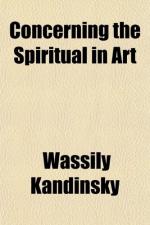Finally, the red horse provides a further variation. The very words put us in another atmosphere. The impossibility of a red horse demands an unreal world. It is possible that this combination of colour and form will appeal as a freak—a purely superficial and non-artistic appeal—or as a hint of a fairy story [Footnote: An incomplete fairy story works on the mind as does a cinematograph film.]—once more a non-artistic appeal. To set this red horse in a careful naturalistic landscape would create such a discord as to produce no appeal and no coherence. The need for coherence is the essential of harmony—whether founded on conventional discord or concord. The new harmony demands that the inner value of a picture should remain unified whatever the variations or contrasts of outward form or colour. The elements of the new art are to be found, therefore, in the inner and not the outer qualities of nature.
The spectator is too ready to look for a meaning in a picture— i.e., some outward connection between its various parts. Our materialistic age has produced a type of spectator or “connoisseur,” who is not content to put himself opposite a picture and let it say its own message. Instead of allowing the inner value of the picture to work, he worries himself in looking for “closeness to nature,” or “temperament,” or “handling,” or “tonality,” or “perspective,” or what not. His eye does not probe the outer expression to arrive at the inner meaning. In a conversation with an interesting person, we endeavour to get at his fundamental ideas and feelings. We do not bother about the words he uses, nor the spelling of those words, nor the breath necessary for speaking them, nor the movements of his tongue and lips, nor the psychological working on our brain, nor the physical sound in our ear, nor the physiological effect on our nerves. We realize that these things, though interesting and important, are not the main things of the moment, but that the meaning and idea is what concerns us. We should have the same feeling when confronted with a work of art. When this becomes general the artist will be able to dispense with natural form and colour and speak in purely artistic language.
To return to the combination of colour and form, there is another possibility which should be noted. Non-naturalistic objects in a picture may have a “literary” appeal, and the whole picture may have the working of a fable. The spectator is put in an atmosphere which does not disturb him because he accepts it as fabulous, and in which he tries to trace the story and undergoes more or less the various appeals of colour. But the pure inner working of colour is impossible; the outward idea has the mastery still. For the spectator has only exchanged a blind reality for a blind dreamland, where the truth of inner feeling cannot be felt.
We must find, therefore, a form of expression which excludes the fable and yet does not restrict the free working of colour in any way. The forms, movement, and colours which we borrow from nature must produce no outward effect nor be associated with external objects. The more obvious is the separation from nature, the more likely is the inner meaning to be pure and unhampered.




